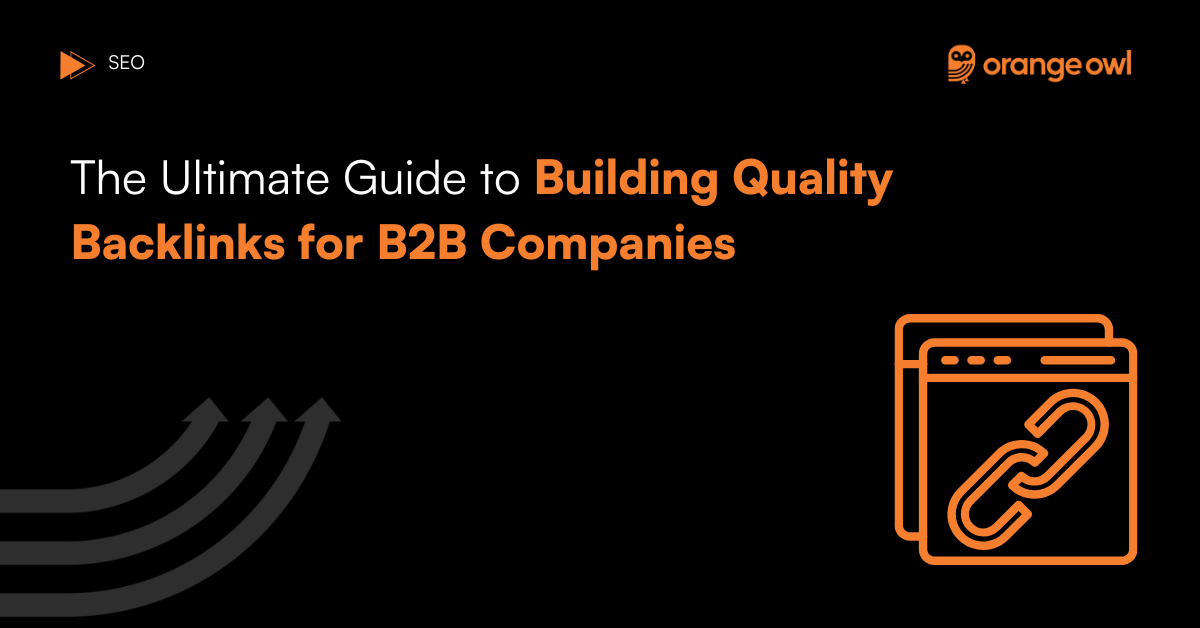The Ultimate Guide to Building Quality Backlinks for B2B Companies in 2025
Vivek Goel
February 8, 2025

Table of Contents
Backlinks are one of the most critical factors in SEO. They serve as votes of confidence from other websites, signaling to search engines that your content is valuable and trustworthy. Building quality backlinks for B2B companies can significantly enhance online visibility, drive traffic, and build credibility. This detailed guide will explore various strategies to build backlinks, complete with B2B examples, tips, useful tools, and best practices. We’ll also discuss the benefits and pitfalls of backlink building.
What are Backlinks?
Backlinks, also called inbound or incoming links, are links from one website to another. They are important for SEO because they act as votes of confidence. Essentially, backlinks show search engines that other websites trust your content. High-quality backlinks can help improve your site’s ranking and visibility in search engine results pages (SERPs).
Here are examples of different types of backlinks for B2B companies:
- Guest Blogging Backlinks:
- A B2B marketing agency writes a guest post for a popular marketing blog, including a link back to their own site. This backlink helps enhance their authority in the marketing industry.
- Editorial Backlinks:
- A B2B software company is mentioned in a Forbes article about innovative tech solutions. The backlink from Forbes boosts the company’s credibility and search rankings.
- Resource Backlinks:
- A B2B financial consultancy firm publishes a comprehensive guide on financial planning. An industry website links to this guide as a valuable resource, providing a high-quality backlink.
- Directory Backlinks:
- A B2B IT services company is listed in an industry-specific directory like Clutch. This backlink helps improve their visibility among potential clients looking for IT services.
- Social Media Backlinks:
- A B2B logistics company shares a case study on LinkedIn, and industry professionals share the link in their posts. While social media backlinks are often nofollow, they can still drive traffic and increase brand awareness.
- Forum Backlinks:
- A B2B cybersecurity firm participates in a Reddit discussion about data security, providing a link to their latest research report. This user-generated backlink can attract targeted traffic and enhance the firm’s reputation.
- Nofollow Backlinks:
- A B2B e-commerce platform gets mentioned in a comment on a high-traffic blog. The link is marked as nofollow, meaning it doesn’t pass SEO value directly, but it can still drive referral traffic and increase visibility.
- Sponsored Backlinks:
- A B2B consultancy firm sponsors an article on a business news website. The article includes a sponsored backlink to the firm’s site, helping to boost traffic and brand exposure.
By securing different types of backlinks from various sources, B2B companies can strengthen their SEO strategy, improve search engine rankings, and enhance their online presence.
Top 5 Benefits of Building Backlinks
- Improved Search Engine Rankings: Backlinks are a significant ranking factor for search engines. High-quality backlinks from authoritative sites can boost your website’s position in SERPs.
- Increased Referral Traffic: Backlinks from relevant websites can drive targeted referral traffic to your site.
- Enhanced Credibility and Authority: Getting backlinks from reputable sources helps build your brand’s credibility and authority in your industry.
- Faster Indexing: Search engines discover new content by following backlinks from existing pages. High-quality backlinks can help new content get indexed faster.
- Higher Domain Authority: Consistent backlink building from authoritative sites can increase your domain authority, further improving your overall SEO.
Types of Backlinks
Backlinks can be categorized into four main types: follow, nofollow, user-generated, and sponsored. Understanding these types and their implications can help you strategically build a robust backlink profile.
1. Follow Backlinks
Follow backlinks, also known simply as “dofollow” links, are the standard type of backlinks that pass SEO value (or “link juice”) from one site to another. These links are crucial for improving a website’s domain authority and search engine rankings.
Example: A B2B software company publishes a guest post on a high-authority technology blog. The blog includes a follow backlink to the software company’s website, thereby boosting its SEO.
2. Nofollow Backlinks
Nofollow backlinks are links that include a “rel=’nofollow'” attribute, instructing search engines not to pass SEO value to the linked site. While they don’t directly boost SEO, they are still valuable for driving traffic and increasing brand visibility.
Example: A B2B marketing agency shares a helpful guide on social media. A popular business forum picks up the guide and shares a nofollow link to the agency’s site. Although it doesn’t pass SEO value, it drives significant referral traffic.
3. User-Generated Backlinks
User-generated backlinks are links that come from content created by users, such as comments, forum posts, and social media profiles. These links can vary in quality and may require monitoring to ensure they are not coming from spammy sources.
Example: A customer of a B2B financial services firm mentions and links to the firm’s blog in a detailed comment on a reputable industry forum. This user-generated link can drive traffic and add some SEO value if the forum is of high quality.
4. Sponsored Backlinks
Sponsored backlinks are links that are paid for, either through direct sponsorship or advertising agreements. These links should include a “rel=’sponsored'” attribute to comply with search engine guidelines and avoid penalties.
Example: A B2B logistics company partners with an industry news site to sponsor content. The news site publishes an article featuring the logistics company with a sponsored backlink, which should be marked appropriately to distinguish it from organic links.
Understanding and utilizing these different types of backlinks strategically can help enhance your B2B company’s online presence while staying compliant with SEO best practices.
Strategies for Building Backlinks
1. Guest Blogging
Guest blogging involves writing articles for other reputable websites in your industry. This strategy not only earns you backlinks but also exposes your brand to a broader audience.
B2B Example: A B2B cybersecurity firm could write guest posts on industry blogs like Dark Reading or Security Magazine, providing insights on the latest cybersecurity trends.
Tips:
- Identify High-Authority Blogs: Use tools like Moz or Ahrefs to find blogs with high domain authority in your niche.
- Pitch Unique Topics: Propose topics that haven’t been covered yet and align with the blog’s audience.
- Include a Natural Link: Ensure the backlink fits naturally within the content, preferably in the author bio or within the article.
Useful Tools:
Best Practices:
- Follow Guidelines: Adhere to the guest blog’s content guidelines and submission process.
- Provide Value: Focus on delivering valuable, well-researched content.
- Build Relationships: Establish long-term relationships with blog owners for future opportunities.
2. Create Shareable Content
Producing high-quality, shareable content such as infographics, whitepapers, and case studies can naturally attract backlinks.
B2B Example: A B2B SaaS company could create an infographic on “The Future of Cloud Computing” and share it across social media and industry forums.
Tips:
- Focus on Quality: Ensure your content is well-researched and professionally designed.
- Promote Extensively: Use social media, email marketing, and industry forums to promote your content.
- Offer Embed Codes: Provide easy-to-use embed codes for infographics to encourage sharing.
Useful Tools:
- Canva: For creating visually appealing graphics and infographics.
- BuzzSumo: To identify popular content topics.
- HubSpot: For creating and promoting comprehensive whitepapers.
Best Practices:
- Research Thoroughly: Ensure your content is backed by reliable data and insights.
- Engage with Influencers: Share your content with industry influencers who might find it useful and share it with their audience.
- Monitor Performance: Use tools like Google Analytics to track the performance and reach of your content.
3. Broken Link Building
Broken link building involves finding broken links on other websites and suggesting your relevant content as a replacement. This strategy not only helps you earn backlinks but also assists webmasters in improving their site’s user experience.
B2B Example: A B2B marketing agency could identify broken links on marketing blogs and offer their latest research report as a replacement.
Tips:
- Identify Broken Links: Use tools like Ahrefs or Screaming Frog to find broken links on relevant websites.
- Reach Out Politely: Contact the website owner, inform them about the broken link, and suggest your content as a replacement.
- Provide Value: Ensure your suggested content is relevant and valuable to the site’s audience.
Useful Tools:
- Ahrefs: To find broken links on websites.
- Screaming Frog: For comprehensive site audits to identify broken links.
Best Practices:
- Personalize Your Outreach: Customize your email to address the website owner by name and explain how your content can help.
- Follow Up: If you don’t receive a response, send a polite follow-up email.
- Offer Multiple Resources: Suggest multiple pieces of content if relevant, increasing the chances of one being accepted.

4. Influencer Outreach
Influencer outreach involves collaborating with industry influencers to promote your content. Influencers can help you reach a wider audience and generate high-quality backlinks.
B2B Example: A B2B HR software company could collaborate with HR influencers on LinkedIn to share their latest industry report.
Tips:
- Identify Relevant Influencers: Use tools like BuzzSumo and LinkedIn to find influencers in your industry.
- Build Relationships: Engage with influencers by commenting on their posts and sharing their content before reaching out.
- Offer Value: Provide influencers with exclusive content or insights that they can share with their audience.
Useful Tools:
- BuzzSumo: For identifying influencers in your industry.
- LinkedIn Sales Navigator: To find and connect with influencers.
- NinjaOutreach: For managing influencer outreach campaigns.
Best Practices:
- Personalize Your Pitch: Tailor your outreach message to the influencer’s interests and audience.
- Provide Clear Value: Explain how your content can benefit their followers.
- Track Engagement: Use tracking tools to monitor the performance and impact of influencer collaborations.
5. Participate in Industry Forums and Communities
Engaging in industry-specific forums and communities can help you build relationships and earn backlinks. Provide valuable insights and link back to relevant content on your site.
B2B Example: A B2B fintech company could participate in discussions on forums like Finextra or Reddit’s r/FinTech, providing insights and linking to their blog posts.
Tips:
- Be Active: Regularly participate in discussions and offer valuable insights.
- Provide Solutions: Answer questions and provide solutions to problems faced by the community.
- Link Naturally: Include links to your content only when it is relevant and adds value to the discussion.
Useful Tools:
- Reddit: For finding relevant subreddits.
- Quora: To answer questions and provide valuable insights.
- Industry-Specific Forums: Like Finextra for fintech or Spiceworks for IT.
Best Practices:
- Follow Community Guidelines: Adhere to the rules and norms of each forum or community.
- Build Credibility: Establish yourself as an expert by consistently providing valuable contributions.
- Avoid Spamming: Only include links when they are genuinely helpful and relevant to the discussion.
6. Publish Original Research and Data
Creating and publishing original research and data-driven content can attract a lot of backlinks. Industry reports, surveys, and case studies are highly valuable resources.
B2B Example: A B2B market research firm could publish an annual industry report based on proprietary research and share it with industry publications and blogs.
Tips:
- Focus on Relevance: Ensure your research addresses current trends and challenges in your industry.
- Promote Widely: Share your research with industry publications, influencers, and on social media.
- Offer Exclusive Insights: Provide unique data and insights that are not available elsewhere.
Useful Tools:
- SurveyMonkey: For conducting surveys.
- Google Forms: For gathering data.
- Tableau: For visualizing data.
Best Practices:
- Ensure Accuracy: Use reliable data sources and validate your findings.
- Make it Visually Appealing: Use charts and infographics to present data in an engaging way.
- Create a Landing Page: Dedicate a landing page for your research to make it easy to share and link to.
7. Utilize Press Releases
Press releases can be an effective way to gain backlinks from news sites and industry publications. Announce new product launches, company milestones, or significant achievements.
B2B Example: A B2B tech startup could issue a press release about securing a new round of funding and distribute it to tech news websites.
Tips:
- Craft a Compelling Story: Ensure your press release is newsworthy and engaging.
- Distribute Widely: Use press release distribution services to reach a broader audience.
- Include Links: Add relevant links to your website or specific landing pages.
Useful Tools:
- PR Newswire: For press release distribution.
- Business Wire: Another press release distribution service.
- PressRelease.com: For affordable press release distribution.
Best Practices:
- Write a Strong Headline: Grab attention with a compelling headline.
- Provide Detailed Information: Include all necessary details and quotes to make your press release informative.
- Follow Up: Contact journalists and bloggers who might be interested in covering your story.
Common Pitfalls in Backlink Building
While building backlinks is crucial for SEO, there are common pitfalls to avoid:
- Buying Links: Purchasing backlinks is against Google’s guidelines and can lead to severe penalties.
- Low-Quality Links: Links from spammy or irrelevant sites can harm your SEO rather than help it.
- Over-Optimized Anchor Text: Using the same anchor text repeatedly can be seen as manipulative by search engines. Vary your anchor text to include branded, generic, and long-tail variations.
- Ignoring Relevance: Ensure the sites linking to you are relevant to your industry to maximize the SEO benefit.
- Neglecting Relationship Building: Focus on building long-term relationships rather than one-off link exchanges.
Conclusion
Building quality backlinks for B2B companies is essential for improving your website’s SEO and establishing your company as an industry authority. By employing strategies such as guest blogging, creating shareable content, broken link building, influencer outreach, participating in industry forums, publishing original research, and utilizing press releases, you can effectively build a strong backlink profile. Avoid common pitfalls, follow best practices, and use the right tools to optimize your backlink building efforts. With a strategic approach, your B2B company can achieve higher search rankings, drive more traffic, and ultimately, grow your business.
Top Frequently Asked Questions (FAQs) on Building Quality Backlinks for B2B Companies
Internal backlinks are links that connect one page of a website to another page on the same website. They help improve navigation and distribute link equity throughout the site.
External backlinks, on the other hand, are links from a page on one website to a page on a different website. External backlinks are crucial for SEO as they signal to search engines that other sites vouch for your content.
High-quality backlink opportunities can be identified by looking for websites with high domain authority, relevance to your industry, and strong organic traffic. Tools like Ahrefs, Moz, and SEMrush can help analyze the domain authority and backlink profiles of potential linking sites. Look for websites that regularly publish quality content and have an engaged audience.
Common mistakes in backlink building include:
- Buying backlinks, which can lead to penalties from search engines.
- Focusing solely on quantity over quality.
- Using spammy or irrelevant sites for backlinks.
- Ignoring the importance of anchor text diversity.
- Not monitoring your backlink profile for harmful links.
To track the effectiveness of your backlink building efforts, use tools like Google Analytics, Google Search Console, Ahrefs, and SEMrush. These tools can help you monitor your backlinks, analyze referral traffic, and measure the impact on your search engine rankings. Track metrics such as the number of backlinks, domain authority of linking sites, and changes in organic traffic and rankings.
Anchor texts, the clickable text in a hyperlink, play a crucial role in SEO. They provide context to search engines about the content of the linked page. Using relevant and varied anchor texts helps search engines understand the topic and relevance of your content. Over-optimized or repetitive anchor texts can trigger penalties, so it’s important to maintain diversity and naturalness.
To earn backlinks from industry publications:
- Create high-quality, original content that offers valuable insights or data.
- Pitch your content to editors and journalists, highlighting its relevance and value to their readers.
- Build relationships with writers and editors in your industry.
- Contribute guest articles or opinion pieces to reputable publications.
- Participate in industry events and share your expertise, which can lead to mentions and backlinks.
While social signals (likes, shares, and comments on social media) do not directly impact search engine rankings, they can enhance your backlink building efforts. High social engagement can increase the visibility of your content, leading to more shares and potentially attracting backlinks from other websites. Social media can also help build relationships with influencers who can link to your content.
Broken link building, when done correctly, does not harm your website’s reputation. It involves finding broken links on other sites and suggesting your content as a replacement. This strategy helps webmasters improve their site’s user experience while earning you valuable backlinks. However, ensure your outreach is professional and your suggested content is genuinely relevant and high-quality.
It’s recommended to audit your backlink profile at least quarterly. Regular audits help you identify and disavow any low-quality or spammy backlinks that could harm your SEO. Use tools like Ahrefs, Moz, or Google Search Console to monitor your backlinks and ensure your link profile remains clean and beneficial.
Advanced strategies for building high-quality backlinks include:
- Conducting original research and publishing comprehensive reports or studies.
- Creating compelling infographics or visual content that others want to share.
- Developing free tools or resources that are valuable to your industry.
- Leveraging public relations to get mentions in news articles and industry reports.
- Collaborating with other businesses on joint ventures or co-authored content.


